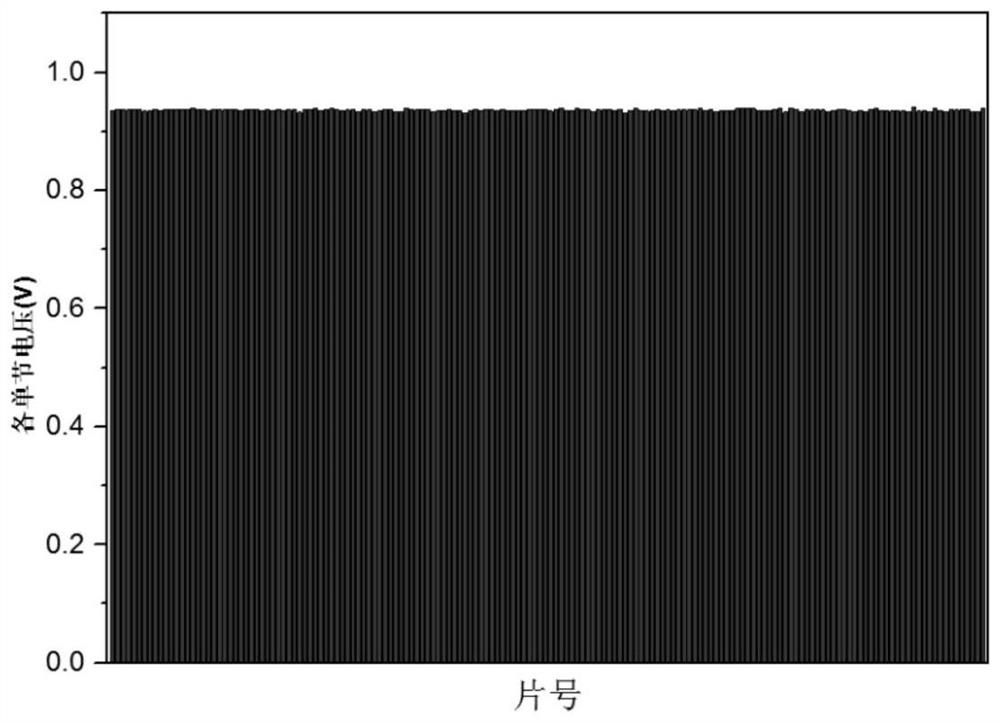Method for eliminating fuel cell coolant pollution
A fuel cell and fuel cell stack technology, applied in fuel cells, circuits, electrical components, etc., can solve problems such as proton exchange membrane pollution, affecting the performance output of fuel cell stacks, and poor stack voltage consistency. Pollution, recovery of MEA catalytic ability, and effect of stack performance improvement
- Summary
- Abstract
- Description
- Claims
- Application Information
AI Technical Summary
Problems solved by technology
Method used
Image
Examples
Embodiment
[0025] Such as figure 1 As shown, when the cooling system accessories (such as the intercooler) fail in the normal operation of the fuel cell stack, the antifreeze in the coolant circuit enters the interior of the fuel cell stack and the single-chip average value is detected by the fuel cell voltage inspection system. If the open circuit voltage is lower than 0.85V, it is judged that the fuel cell stack is polluted by coolant, and the following methods are used to eliminate the pollution of fuel cell coolant. The specific steps are as follows:
[0026] 1. Place the proton exchange membrane fuel cell polluted by the coolant on the test bench, and set the operating temperature of the fuel cell to 50-65°C. A certain flow rate of humidified oxidizing gas is used to purge the cathode and anode of the fuel cell at the same time. The above steps promote the desorption of anions such as carboxylate adsorbed on the surface of the MEA catalyst, and the direction of the purge gas intake ...
Embodiment 2
[0031] The oxidizing gas described in step (1) is pure oxygen or air, its working pressure is 1kPa, the flow rate is 1*nslpm, n is the number of fuel cell stacks, n≥1, the humidity is 30%, and the purge time is 60min.
[0032] The reducing gas described in step (2) is pure hydrogen, its working pressure is 1kPa, flow rate is 0.5*n slpm, n is the number of fuel cell stacks, n≥1, humidity is 30%, and purge time is 60min .
[0033] Step (3) When the fuel cell stack is activated, the air at the cathode and the hydrogen at the anode adopt the stoichiometric mode, the stoichiometric ratio of the cathode is 1.8, and the stoichiometric ratio of the anode is 1.5.
[0034] All the other are with embodiment 1.
[0035] After the fuel cell stack is processed by the above method, the average voltage of the single chip is restored to about 0.94V, and the performance of the stack is improved by about 30-45%.
Embodiment 3
[0037] The oxidizing gas described in step (1) is pure oxygen or air, its working pressure is 80kPa, flow rate is 2*nslpm, n is the number of fuel cell stacks, n≥1, humidity is 100%, and the purge time is 30min.
[0038] The reducing gas described in step (2) is pure hydrogen, its working pressure is 80kPa, the flow rate is 1*n slpm, n is the number of fuel cell stacks, n≥1, the humidity is 100%, and the purge time is 30min .
[0039] Step (3) When the fuel cell stack is activated, the air in the cathode and the hydrogen in the anode adopt the stoichiometric mode, the stoichiometric ratio of the cathode is 2.5, and the stoichiometric ratio of the anode is 1.5.
[0040] All the other are with embodiment 1.
[0041] After the fuel cell stack is processed by the above method, the average voltage of the single chip is restored to about 0.96V, and the performance of the stack is improved by about 30-45%.
[0042] Using the above method, the cathode and anode of the fuel cell sta...
PUM
 Login to View More
Login to View More Abstract
Description
Claims
Application Information
 Login to View More
Login to View More - R&D
- Intellectual Property
- Life Sciences
- Materials
- Tech Scout
- Unparalleled Data Quality
- Higher Quality Content
- 60% Fewer Hallucinations
Browse by: Latest US Patents, China's latest patents, Technical Efficacy Thesaurus, Application Domain, Technology Topic, Popular Technical Reports.
© 2025 PatSnap. All rights reserved.Legal|Privacy policy|Modern Slavery Act Transparency Statement|Sitemap|About US| Contact US: help@patsnap.com



